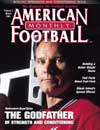AMERICAN FOOTBALL MONTHLY THE #1 RESOURCE FOR FOOTBALL COACHES
Article CategoriesAFM Magazine
|
Running On EmptyDo you train your quarterbacks to throw like a shot putter? Then why do you train your football players to run like a track star?© More from this issue FOOTBALL PROGRAMS HAVE BEEN TIMING PLAYERS in the 40 yard dash for years and making evaluations based on the results. But while the test is time-honored, is it really an accurate assessment of how fast a player will be on the field on any given Saturday? As an expert in speed development for football players, I feel that straight line sprint speed is only a partial assessment of an athlete's playing speed. The reason is obvious. Few football players run full bore for 30 to 50 yards during a game. In contrast, all players need to make variable speed changes to be effective on the field. Some coaches are aware of this, yet continue to strive to improve 40 times and develop straight-line speeds.What we really need is a better measuring tool for assessing football speed. Often you'll see a 4.5 guy who has a slower athletic speed ....The full article can only be seen by subscribers.
|
|
|||||||
| HOME |
MAGAZINE |
SUBSCRIBE | ONLINE COLUMNISTS | COACHING VIDEOS |
Copyright 2025, AmericanFootballMonthly.com
All Rights Reserved





